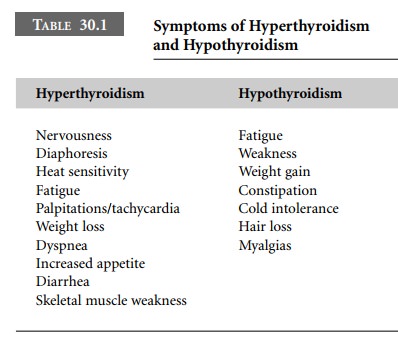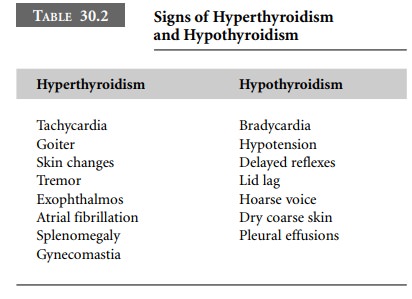Chapter: Clinical Cases in Anesthesia : Thyroid Disease
How are thyroid disorders evaluated?
How are thyroid disorders evaluated?
Thyroid disorders can be suspected based on a
patient’s history, findings on physical examination, and/or
A
thorough his-tory and physical examination are essential for evaluation and
will assist in determining whether the patient is clini-cally euthyroid,
hypothyroid, or hyperthyroid. Symptoms associated with hyperthyroidism and
hypothyroidism are shown in Table 30.1. The physical examination should focus
on the signs of hyperthyroidism and hypothyroidism (shown in Table 30.2), as
well as the size and position of the thyroid, palpable nodules, and tracheal
position.

Standard laboratory evaluations of thyroid
function include TSH and free serum T4 levels. Initially, an
ultrasen-sitive TSH level is obtained and, if abnormal, then a free T4
level is obtained. Because greater than 99% of circulating thyroid hormone is
bound to thyroxine binding globulin (TBG), total T4 levels may be
deceiving. Increases in TBG (pregnancy, estrogen therapy) or decreases in TBG
(cirrhosis, nephrotic syndrome) may
result in abnormal levels of total T4 but normal levels of free T4.

In hyperthyroidism, the TSH levels will be low
and the T4 levels will be high. If the serum T4 level is
normal, a T3 level should be obtained. In hypothyroidism, the TSH
level is high in intrinsic thyroid gland abnormalities or low in hypothalamic
or pituitary gland abnormalities.
Imaging studies can be helpful in evaluating
thyroid dis-orders. Radioactive thyroid uptake scans are important for
determining whether thyroid nodules are active (“hot”) or inactive (“cold”).
Hot nodules are rarely malignant. Ultrasound can be used to determine the size
and number of thyroid nodules. CT scan or magnetic resonance imag-ing (MRI)
will show the size of the thyroid, compression of neighboring structures, and
the presence of lymph-adenopathy.
Related Topics